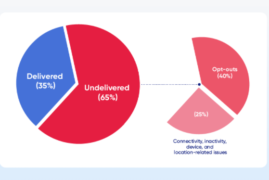Imagine you’re an up and coming brand in the ultra-competitive social networking app space, and you need to create a splash in the market. You want to get as many eyeballs on your social networking app and build instant credibility with your target audience. You approach a trendy social media influencer on Instagram or TikTok. They love your game or free movie app enough to introduce it to the countless masses who follow their every post. Fasten your seatbelt and prepare to go viral. And the best part? You only pay when a user installs your app.
Wow. Sounds perfect, right? It’s pretty close if your company wants mass exposure and social validation with no upfront risk.
How Does It Work?
Social influencer marketing has been on the radar for roughly five to 10 years, but the performance-based version is more recent. Most social influencer marketing is still “pay per post” with brands paying influencers a set fee upfront. With the affiliate or performance-based model, advertisers only pay when influencers drive installs.
Matt Swim, Strategic Account Manager with AdAction, describes the recent emergence of the performance-based option. He remarked, “Performance-based social influencer marketing has gotten big in the last year, starting to take off in the last six months with the explosion of mediums like TikTok.”
According to a Nielson report, a whopping 92% of consumers believe suggestions from friends and family above all other forms of advertising. Social media influencer marketing relies on the power of “word of mouth,” but the difference is the words don’t come from friends or family, but rather from sources held in high regard by the target audience.
A successful influencer marketing campaign typically follows these steps:
Analyze the Audience
It’s critical to know everything about the target audience from the beginning. Who is the audience? What are their demographics, values, interests, and needs? What are the current trends, and who are the trendsetters in their space?
Research and Choose Best Influencers
Once the target audience is known, you can create a list of potential influencers. From this list, select the leading influencers based on the vertical of the product. Choosing appropriate influencers for the audience may be the most critical decision in determining a campaign’s success.
Engage Influencers and Set Metrics
To ensure everyone wins, you should present influencers with a strong monetization proposal. It should include measurable goals set to define success. What key performance indicators (KPIs) matter most? Installs? ROI? Retention? Identify each and how they will be quantified to gauge success.
In a performance-based model, each social influencer receives a trackable code or link for users to click. All user clicks on this link will result in credit and payment to the influencer. The influencer gets a reward for their efforts while the advertiser can quickly and easily identify profitable value streams.
Influencers must drive results to get paid. Everything rides on the influencer creating a “hook” in the form of engaging content to trigger user action. The engaging post will entice the user and allow them to see the product’s value or benefit. Again, it becomes apparent how important selecting the correct influencers can be.
Monitor Results and Optimize Strategy
Performance-based social influencer marketing delivers trackable results. Regardless, if the campaign explodes or flops, the good news with a performance-based model is transparency. Advertisers must monitor results to optimize campaigns continuously. With a wealth of trackable metrics, it’s easy to spot the productive influencers and the laggards; then adjust the strategy accordingly.
What Are the Benefits?
Performance-based social influencer marketing succeeds because of the trust influencers build with followers. Their validation provides compelling social proof, giving instant legitimacy to a brand or product. Influencers can deliver from a casual, non-pushy angle with the product endorsement alongside content the user willingly selects. These factors, combined with social media’s reach and power, and a results-driven pay model, delivers numerous marketing advantages.
Key Benefits of Performance-Based Social Media Influencer Marketing
- Did we mention low risk? That’s right—influencers get paid on actions driven. What’s not to like about only paying for measurable results?
- This marketing model benefits from the enormous reach and scale of social media. Wise advertisers recognize television is yesterday, and social media is now the top marketing medium. Unsure as to the influence of social media on buyers today? 61% of consumers rely on social media as the most crucial source of info when shopping.
- Want to go viral? Teaming with the correct influencer who engages your audience with top content can result in millions of eyeballs on your app virtually overnight.
- By setting trackable goals out of the gate, advertisers can quickly and easily monitor campaign progress and optimize the strategy to drive superior results.
- Performance-based social influencer marketing excels at delivering quality users—ones that are more engaged, ready to buy, and likely to stick around.
- A successful performance-based social influencer campaign can skyrocket brand awareness, boosting App Store rankings and organic traffic.
On the flip side, detractors mention the danger of linking with fake (they pad their follower list with bots disguised as people) or suddenly shady influencers. They lament the unpredictable nature of this marketing model. In response, choosing legitimate influencers is critical to a campaign’s success. Working with a proven company that constantly vets the influencer mix can make all the difference. It’s also true predicting whether an influencer’s content will succeed or flop is difficult. Remember, with a performance-based model, you don’t pay for failure.
Low Risk, High Reward
With a relatively short history and the uncertainty of newcomer status, many brands hesitate to give performance-based social media influencer marketing a look. However, Brooks Hurbis, Team Lead Business Development at AdAction, has some advice for those considering it. She said, “I think this is only the beginning of this channel for mobile apps, and with the explosion of popular mediums like TikTok and Instagram, the volume will only continue to grow. I believe it’s in an advertiser’s best interest to get in early on this channel as a pioneer.”
This is excellent advice for companies wanting to gain more users and quickly boost brand awareness, especially in the cutthroat mobile app market. Social influencer marketing continues to validate two potent truths. People buy from those they trust, and social media reaches more people faster than any other medium available today. For brands wanting rapid reach and maximum influence while only paying for results, employing a performance-based social influencer marketing model appears a worthwhile, low-risk proposition.

android app ranking

